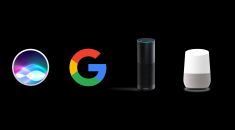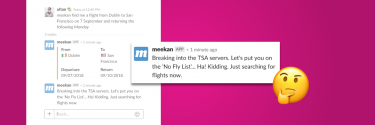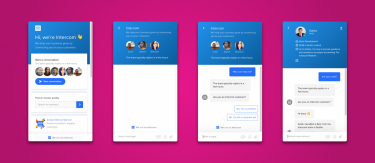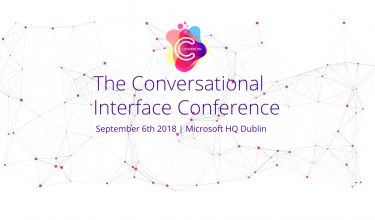
#innovation #alexa #google-home

15. Oct 2018 |
- min Lesezeit
“
Bots don’t need to act human to be human-centered.
“
Speaker: Ultan O’Broin (Digital Transformation Consultant)
Ultan took us on a wild trip from bot personality, artificial intelligence until artificial humor. His key statement is that there is no need to implement all of the subtle nuances of human personality into a human-computer interaction, but only the dominant, memorable, important personality traits that will be useful to the interaction in that particular context. Some startups (e.g. Howdy and X.ai that schedule meetings via conversation) even hired writers with a performing-arts background to support their UX team to define the personality.
An often negligently used pattern is humor to “spice up” your conversation. But humor is not only the final frontier for AI, it’s part of your bot’s personality that is easily misunderstood - or lost in translation. That’s why you should be very selective when you use loose statements or even jokes to personalize your bot. It’s all about context - and especially timing!
He showed an example of Meekan slack bot. When searching for a flight it displays a processing message “Breaking into the TSA servers. Let’s put you on the NO FLY LIST… Ha! Kidding. Just searching for flights now.”
Choose wisely which elements help to deliver the best possible UX.

One of his recommended resources is a helpful webinar about “Create a voice and tone your customers love”. Here is the key essentials when defining personality for a conversational interface:
Define who you are: a recognizable archetype, not necessarily a specific character. For example: friendly, childishly cheerful, serious, old-fashioned, accountant-speak.
Your principles shape your relationship with customers and guide what you say. You can use short memorable phrases, or be opinionated and up for debates.
Your attributes are the traits of your personality and guide how you say what you say. Be original, authentic, unique to your brand or dimensional.
Style is the nuts and bolts of how you communicate and the conventions you follow. It ensures in how you spell, punctuate and so on. For example you can be specific with examples, use active voice, simple tenses or first person plural.

We don’t need bots to display emotion, we need them to detect emotion. #ConverCon18 Intellectual Empathy?
— Mitch Lieberman (@mjayliebs) 6. September 2018
Speaker: Kostya Gorskiy (Design Manager, Intercom)
Kostya is former design lead at Yandex from Russia. He’s now working for Intercom who’s chatbot icon you have probably seen multiple times around the web.
Intercom’s vision is to enable you, to build the most personal communication to your customer. They built a suite of messaging-first products to accelerate growth across the customer lifecycle, from acquisition, to engagement, and support.
As a concepter you often struggle to visualize the whole interaction flow. You can use a flow diagram like you did in the old days with websites - but that get’s chaotic when you have multiple branches or users switch between pre-defined storylines.
At Intercom they tried flowcharts, WYSIWYG editors and finally ended up in a framework with GOTO in combination with a WYSIWYG editor. This approach delivers the most flexibel and transparent way to build and continuously improve your bot.
Tired of flowcharts to design a bot? Great approach for a WYSIWYG GoTo Bot Builder by @intercom @k00 #convercon18 pic.twitter.com/KATmZsXtbp
— DieProduktMacher (@ProduktMacher) 6. September 2018
His UX team introduced some smart UI elements to point out to whom you are talking to. If it’s a human or a bot. As well as an indication when a human will respond to your question. In the beginning customer service employees experienced strange behaviour from their users. Speaking in commands and bearish reactions expecting they are talking to a machine, although they were already redirected to a real service employee.
So, better make it clear to who you are talking to!

“
With every interaction your customer gets more or less engaged. They never stay the same.
“
Speaker: Max Amordeluso (EU Lead Evangelist, Amazon Alexa)
Of course, there can’t be a conversational conference without an Alexa Evangelist.
For my personal daily routine Alexa unfortunately didn’t win the challenge against my existing devices. That’s why I somehow “lost the connection” to their updates and was really curious which new features Max Amordeluso would introduce to the crowd. Here’s a short summary since it is all well documented on their pages:
“
Are you looking for batteries or Duracell? There is 30% less brand naming when ordering with voice. Are we moving from brands to intents? How will brand marketers get their brands listed?
“

Speaker: Grace Hughes (Senior Content Designer, Fjord)
Initially Paige McGuire (Creative Director, Fjord) was intended to give a talk about “Conversation Design for Disappearing Interfaces”. You can find her inspiring talk over here:
Conversation Design for Disappearing Interfaces - 2018 Design & Content Conference
Grace Hughes replaced her, who has a strong background in content and copywriting. First part of her presentation focussed on summing up a typical website project. While UX Design is working on concept and visual moods, you are still waiting for the entire amount of content and final texts. So you start working with old material or even dummy text. Ever heard one of these phrases, like “We already have most of the content” or “We will deliver the final text afterwards”?
In times of conversational interfaces the whole workflow changes. Text and content are a must before you start.
You can’t build a conversation on Lorem ipsum dolor!
"Lorem ipsum is dying. You can't build a conversational interface without the actual information." #convercon18 pic.twitter.com/3hQuNAqtjU
— DieProduktMacher (@ProduktMacher) 6. September 2018
Second part of her presentation addressed some ethical questions and the social worth of conversational interfaces.
The chatbot Spot helps employees who experienced sexual harassment in their workplace. “It’s incredibly easy to forget things or misremember them,” says Co-Founder Dr. Julia Shaw, “which is why it’s important to record them when the memories are fresh.” When a conversation lasts longer than 10 minutes, the bot creates a PDF with all answers and a formal-looking cover sheet, that can be emailed to your HR or anyone else.
She ended her talk with an open ethical question regarding Google Duplex:
“
Is it fine that Google Duplex doesn't tell the respondent it's a bot?
“
Voice and conversational interfaces are happening right now! Take the chance and be part of this exciting revolution.
Let’s talk how to use speech in voice assistant and conversational interfaces for your business! Get in touch: kontakt@produktmacher.com
You want to work in the fields of VoiceUI, Natural Language Processing and Machine Learning?
We are hiring!

